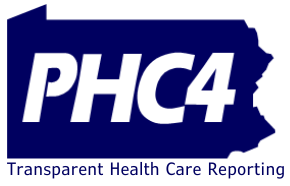Contact: Joe Martin
717-232-6787 or
NEW STATE REPORT – ONE IN 37 HOSPITALIZATIONS RELATED TO OPIOIDS
Harrisburg, PA – October 16, 2018 – In 2017, 1 in 37 hospital admissions were opioid-related according to a research brief released today by the Pennsylvania Health Care Cost Containment Council (PHC4)âpart of a series of briefs produced by the agency on this topic. This edition extends PHC4âs previous analyses on opioid overdose to include hospitalizations related to opioid use disorder (opioid dependence and abuse).
The number of opioid-related hospital admissions increased 103.6% between 2008 and 2015, from 14,711 admissions to 29,958âfigures that are likely underestimated based on new hospital coding requirements that became effective late in 2015. There were 36,522 opioid-related hospitalizations in 2016 and 36,712 in 2017. Analysis includes Pennsylvania residents age 15 and older.
âThese findings show a bigger picture of what we are facing with the opioid crisis and suggest how important it is to get immediate help to those addicted to opioids and to also identify lasting solutions to battle this problem,â said Joe Martin, PHC4âs Executive Director.
In 2017, overdose was the primary reason for admission in 9.5% of the opioid-related hospitalizations. Opioid use disorder was the primary reason for 7.5% of the admissions. In these instances, patients did not overdose but, rather, had withdrawal and/or other symptoms. The remaining 83.0% of patients were in the hospital for another condition but also had opioid use disorder as a co-occurring condition. The top reasons these patients were hospitalized include mental health disorders, substance and alcohol related disorders, and septicemia and skin infection, conditions often affecting injection drug users.
While residents in age groups 15-34 and 35-54 comprised 35.2% of all hospitalizations, they represented 72.0% of the opioid-related admissions. Residents age 55 and older accounted for 64.8% of all hospitalizations and 28.0% of opioid-related admissions.
In 2017, Medicaid was the anticipated payer for 44.3% of the opioid-related hospitalizationsâthe largest percentage among the payer groups. As a comparison, Medicaid comprised 16.9% of all hospitalizations that year. Medicare was the anticipated payer for 27.5% of the opioid-related hospitalizations, compared to 52% of all hospitalizations. Commercial payers made up 23.5% of the opioid-related hospitalizations and 28.3% of all hospitalizations.
Among the income groups studied, residents living in lower income areas (where the average household income is less than $30,000 a year) had the highest rate of opioid-related hospitalizations at 788.6 per 100,000 residentsâa rate 128% higher than the statewide rate of 345.9 per 100,000.
By age group, residents age 35-54 had the highest rate at 430.9 per 100,000 residentsâ24.6% higher than the statewide rate.
The brief also looked at rate differences by race/ethnicity, female/male, and rural/urban residency. The rate for black (non-Hispanic) residents was 419.9 per 100,000â21.4% higher than the statewide rate. Males had a higher rate than females (369.6 and 323.6 per 100,000, respectively). At a rate of 361.1 per 100,000, residents living in urban counties had a higher rate than residents living in rural counties (304.9 per 100,000).
County-level population-based rates are also included in the brief.
The brief is available on PHC4’s website at www.phc4.org. You can also link to it through social media on Facebook and Twitter.
PHC4 is an independent state agency charged with collecting, analyzing and reporting information that can be used to improve the quality and restrain the cost of health care in Pennsylvania.

